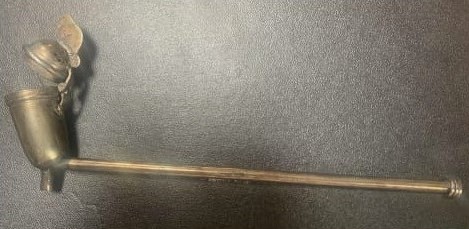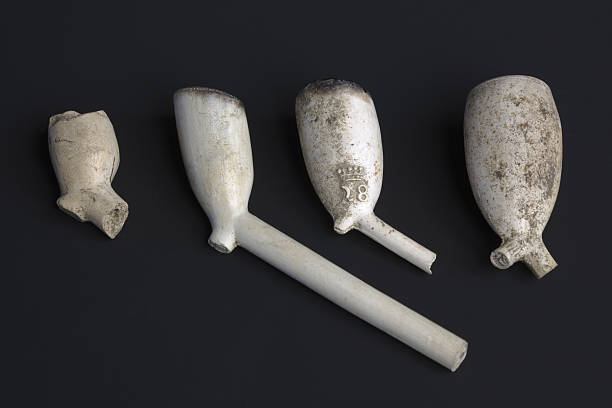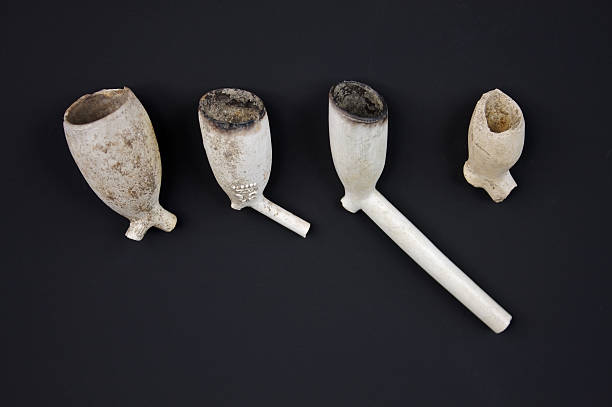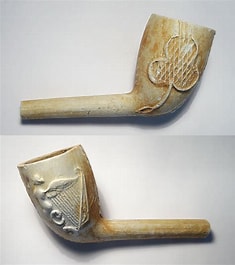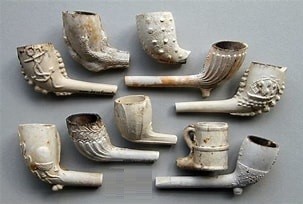Questions On An Old Pipe
Page 1 of 1
 Questions On An Old Pipe
Questions On An Old Pipe
.
Questions On An Old Pipe (a little off topic but still within the period).
I was asked about this old pipe that an antique dealer was trying to sell, were these common, is this pipe really a good buy, is it as old as stated by the dealer??? Lots of questions about the history and did is really exist and for what time period.
I have seen similar pipes with the same bowl covering over the years, how correct was always the question.
England is always a good source for pipe smoking and history of the sport.
I find these lids very handy not only in windy conditions but also to prevent the tobacco from falling out. I don't like to carry a tin or a pouch around, I just pack a pipe with folded flakes and I'm good for an hour or two which often equals to my daily smoking time. Sometimes I just want a short smoke and simply cover the pipe after it. If the lid doesn’t fit correctly over the chamber, there’s a mess in my pocket. Before finding a suitable lid, I ended up with burnt out pockets. I need something that fits the bigger chamber (20mm and up). I don't even need those holes in it, I just want to cover the chamber so I can put it in the pocket without worries.
I checked at the library on the subject and will show what I found as of date (see below).
History of Clay Pipes
The history of clay pipes dates to at least the 16th century, with some scholarly sources indicating they were produced in England around 1558, shortly after the introduction of tobacco from North America. Other sources believe the clay pipe was likely introduced to Europe following Sir Walter Raleigh's 1585 Virginia expedition. According to a 2012 article titled "Evolution of clay tobacco pipes in England" published by the Cambridge Archaeological Field Group, "The earliest written description of smoking was in 1573 and probably described a pipe derived from native North American types." England was a major producer of clay pipes by the early 1600s though attitudes toward smoking dramatically changed with the death of Elizabeth I and the succession of King James I. The English monarch voiced his distaste for smoking in his 1604 treatise A Counterblaste to Tobacco and also instituted a 4,000 percent tax increase on tobacco.
In The Book of Pipes & Tobacco, Carl Ewha notes responses to the king's drastic actions.
Long before meerschaum and briar were utilized as pipe-making mediums, clay was the primary material used to make pipes. Clay pipes were at one time ubiquitous, often smoked in taverns, churches, and homes, and even after meerschaum became available, they were the choice of many because meerschaum was expensive. Clay pipes have been smoked for centuries and modern incarnations are nearly identical to early examples from hundreds of years ago in regard to the materials used and manufacturing methods. In addition to their classic appeal, clay pipes require no break-in and are renowned for their high level of heat resistance and flavor-neutral smoking qualities. Tobacco blenders use clays for testing purchasing leaf and potential blends because of that neutrality, enabling them to experience a blend or leaf varietal in its most accurate form. Along with providing an ideal way to sample new blends, clay pipes are also excellent for revisiting a favorite mixture and gaining a new perspective.
History of Clay Pipes
The history of clay pipes dates to at least the 16th century, with some scholarly sources indicating they were produced in England around 1558, shortly after the introduction of tobacco from North America. Other sources believe the clay pipe was likely introduced to Europe following Sir Walter Raleigh's 1585 Virginia expedition. According to a 2012 article titled "Evolution of clay tobacco pipes in England" published by the Cambridge Archaeological Field Group, "The earliest written description of smoking was in 1573 and probably described a pipe derived from native North American types." England was a major producer of clay pipes by the early 1600s though attitudes toward smoking dramatically changed with the death of Elizabeth I and the succession of King James I. The English monarch voiced his distaste for smoking in his 1604 treatise A Counterblaste to Tobacco and also instituted a 4,000 percent tax increase on tobacco....
Found In The Book of Pipes & Tobacco, Carl Ewha notes responding to the king's drastic actions on tobacco.
Needless to say, life became miserable for those who favored or trafficked in tobacco. But pipe makers did not take the king's abuses quietly. When Sir Walter Raleigh, that avid and persistent pipe smoker, was charged with treason and executed, English pipe makers began to champion their hero posthumously with pipes that had his effigy molded into the bowls. King James was furious and in 1620, after many unheeded warnings of the consequences of such defiance, set up a pipe makers' guild in London and made any practice outside the guild unlawful. Pipe Makers began leaving the country in great numbers for Holland, and the Dutch and English-turned-Dutch began to control the clay-pipe industry. (pg. 45).
Despite several pipe craftsmen in England and Holland, the shaping of clay pipes changed very little and they primarily varied in overall length, with makers producing designs ranging from Nosewarmer length to long, willowy Churchwardens. Academic sources note that Holland-made clay pipes were typically shorter, smaller, and thinner compared to English pieces. Dutch clays tended to be more intricately detailed and were typically polished until the finish was glossy.
It's the stylized, artistic flourishes that make historical clay pipes particularly fascinating, with carvings and engravings reflecting the smoker's religious views, political affiliation, or occupation. Woodworkers would also create intricate hinged cases and ornate pipe racks while metal craftsmen produced pipe tools and tobacco boxes. In Carl Ewha's book it's noted, "At one point the smoking of clay pipes became so popular that a pipe cleaners' trade was established. It was thought important even then to have a clean pipe, and periodically one's pipes were bundled together on a special stand and sent to the bakehouse for purification." (pg. 48).
In order to thoroughly clean clays, they were often placed in an oven or laid over a bed of hot coals to remove carbon cake inside the tobacco chamber and return the material to its original white color.
"The earliest written description of smoking was in 1573..."
Clay pipes excavated and dated by the Cambridge Archaeological Field Group showed, "By 1750 pipes with masonic arms, public house symbols and military regimental badges were all being made." Some pipes were often decorated for advertising purposes or to commemorate special events. Historical clay pipes discovered around the world are dated using several techniques, including examining known maker's marks and using a typology based on the progression in bowl shape. The diameter of the stem bore was used to date clay pipes that were made up until 1800, with smaller holes indicating the pipe was fashioned closer to the start of the 19th century. Some Cutty-shaped clay pipes notably featured a curled heel spur, which was originally used for resting the hot bowl on a surface without burning that surface.
Another area where clay pipes were heavily used was Williamsburg, Virginia, as tobacco was a crucial economic pillar during the city's colonial period. A piece written by esteemed British archaeologist Ivor Noël Hume published in the winter 2003-04 edition of the Colonial Williamsburg Journal and titled "Hunting for a Little Ladle," mentions thousands of clay pipe fragments discovered in the historical city.
Here are a few of the pipes we found (my father and a few friends) on the Brandywine Creek were Revolutionary soldiers camped during that war. They would have tin pails full of different items found on their weekend adventures searching such areas of the F&I War, Rev. War and Civil War fought in PA, OH, NY.
Hume also describes how clay pipes were smoked in taverns centuries ago:
An early explanation for their ubiquity had it that in colonial-era taverns pipes passed from mouth to mouth, but that in the interests of hygiene the previously lip-gripped section was broken off and thrown away. There is no documentary support for that notion, but it is known that used pipes were placed in iron cradles and heat cleansed in bake ovens before being issued to the next round of smokers.
The piece also touched on the difficulties of dating clay pipes from the London pipe maker's guild:
Although the guild of tobacco pipe makers had been established in London as early as 1619, prompting makers to identify their products by inscribing their marks or initials on the bases of bowls, very few of them supplied a date. Most of those that did came from the pipe-making center at Broseley in Shropshire and were stamped with dates in the last quarter of the seventeenth century. As the bowls on which dates appeared varied in shape, and as the dates probably referred to the maker's acceptance into his guild and not to the pipes on which they appeared, all this evidence was as confusing as it was helpful.
The lifespan of clay pipes was relatively short throughout the 17th and 18th centuries, lasting only one to two years until they were discarded. (Hume, 1969). However, even after they broke and could no longer be used for tobacco consumption, there were alternative uses for pieces of clay pipe stems. Archaeological evidence found that the most common reuse of stem fragments was in the form of whistles, which have been primarily discovered in the United States' Middle Atlantic region but also European settlements in Africa. Another notable way clay pipe stems were recycled was discovered when an 18th century walkway was excavated in Colonial Williamsburg, revealing that over 15,000 pipe stems were used as paving material. (Hume, 1974).
In addition to practical and creative ways of reusing clay pipe stems, there's evidence that they were utilized as weapons, according to at least two historical cases. The earliest recorded example occurred in London in 1615 when one pipe maker stabbed another pipe maker in the eye with a pipe stem, killing him. A similar event transpired in 1666 during an argument between two men, culminating in one of them being killed by a pipe stem. (Walker, 1976).
Carl Ewha's book briefly mentions how clay pipes fell out of favor, "The popularity of the clay pipe began to decline shortly after World War I. The life style was changing, and more practical, durable pipes were needed which could be carried easily and were more comfortable to hold. Briar, which had come on the scene in the 1850s, satisfied this demand. Clay pipes, along with the leisurely life they symbolized, became increasingly part of the past." (pg. 59).
How Clay Pipes are Made
For crafting clay pipes and this can be a mess if you try it, The clay is typically ground in a mill and mixed with water so that it provides a smooth, workable texture. A lump of clay is then rolled to form what will be the shank and stem, while a larger blob is shaped on one end for the bowl shape. Next, a thin metal wire, or piercing rod, is threaded through the stem and shank to create an airway and is left in place while the crudely shaped pipe is placed into a halved mold that features holes and each end. There are also other techniques makers employ to create an airway, such as rolling the shank with a thin reed inside.
Using a hand press or vice, the mold is tightly shut and after the excess clay is forced out, a reaming device is pushed into the large end of the mold to form the bowl's chamber. Afterward, the pipe is taken out of the mold and the wire is removed from the shank. At this point, additional decoration can be applied to the pipe's surface, including rouletting, also called milling, along the edge of the bowl using a small knife. After the clay is given several days to dry, any excess is carefully scraped off to remove rough surfaces and the pipe is placed in a kiln to bake for several hours until it completely hardens. Some clay pipe makers will then polish the pipe and glaze the stem so that it won't stick to the smoker's lips. There are also clay pipes that feature vulcanite or acrylic mouthpieces for those who prefer a stem material that is familiar and durable. In his 1977 book Clay Tobacco-Pipes, with Particular Reference to the Bristol Industry, Iain C. Walker noted that a skilled pipe maker centuries ago was capable of producing up to 3,000 undecorated pipes a week.
As someone who is enthralled by history and pipe smoking, I thought it was essential to finally add a clay pipe to my collection. I opted for an Old German Clay piece crafted by Markus Fohr, a pipe maker from Montabaur, Germany, whose family has been making clay pipes for generations. Fohr still uses molds of brass and iron that are over 240 years old, utilizing the famous clay of his region in Germany, clay that has a worldwide reputation for its use in fine pottery.
I was initially nervous about smoking a clay pipe as I was uncertain how hot the bowl would become while smoking, if there'd be any detectable clay taste, and if my smoking sessions would be significantly shorter due to the smaller bowl size than what I typically smoke. There's also the lingering fragility associated with clay pipes — I worried that if I so much as looked at my clay the wrong way it would spontaneously snap in half. However, after smoking it several times my worries were put at ease and I was amazed at how wonderful a clay pipe can be.
Clay Pipes
While the bowl did indeed become quite hot while smoking, I found the easiest way to avoid burning my hand was to gently pinch the shank near the transition with my thumb and forefinger. Over time, I learned to gradually slow my puffing cadence to reduce the chance of an overly hot bowl. That methodology has carried over to my briar pipes, greatly increasing my smoking enjoyment as well as making me a more disciplined and self-aware pipe smoker. Changing my puffing rhythm while smoking my clay pipe also ensured each bowl lasted for a sufficient time, despite its smaller bowl compared to the rest of my collection. And each time I smoked my clay, I lightly applied water to the mouthpiece to avoid the material sticking to my lips.
I did not notice any sort of clay taste while smoking the pipe; instead I picked up flavors and notes in blends I previously overlooked or struggled to notice with my briars. There were some blends where I could more fully appreciate the smokiness of Latakia, the grassy and hay-like notes of straight Virginias, or the natural nuttiness of Burleys. If blends contained Perique, I was able to discern whether it had more of a sweet, chocolatey taste or a savory, mushroom and soy sauce profile.
...a skilled pipe maker centuries ago was capable of producing up to 3,000 undecorated pipes a week …
In addition to the clay's fragility, it's important to be mindful of the amount of carbon build up in the chambers as significant amounts of carbon will cause cracking much faster than will briar. Gently wiping the chamber after each smoke with a napkin, paper towel, or pipe cleaner will help guard against excessive and potentially harmful carbon build up. Reaming the chamber to remove carbon cake should be avoided as it's extremely risky and will likely damage the clay. The best way to clean your clay pipe is, after smoking has discolored it, to place it in a bed of hot coals in a fire, the heat of which will clean and purify the pipe to like-new condition, removing some of the more stubborn cake build up in the process. It should be noted that if this is done to a black clay pipe, the finish will turn white.
Though clay pipes may be viewed by some as historical artifacts, they continue to serve as useful smoking instruments that afford us the opportunity to taste mixtures and individual blending components in their purest form while also reliving the smoking experiences of generations ago. If you've been hesitant about purchasing a clay pipe, I highly encourage you to pick one up. Clays come in a variety of styles and sizes, and it's highly likely there is one that will suit anyone's preferences. They're a small investment but provide a large return, and are capable of lasting for several years with proper care and maintenance.
We were asked about the “hinged covering on pipes”, from what we know they were not available (found in history records, historical sources, etc. until the late 1890’s early 1900’s). Be aware with your purchases ... You will find traders trying to sell this idea as being early, no reference has been found at this time.
[/i]
Questions On An Old Pipe (a little off topic but still within the period).
I was asked about this old pipe that an antique dealer was trying to sell, were these common, is this pipe really a good buy, is it as old as stated by the dealer??? Lots of questions about the history and did is really exist and for what time period.
I have seen similar pipes with the same bowl covering over the years, how correct was always the question.
England is always a good source for pipe smoking and history of the sport.
I find these lids very handy not only in windy conditions but also to prevent the tobacco from falling out. I don't like to carry a tin or a pouch around, I just pack a pipe with folded flakes and I'm good for an hour or two which often equals to my daily smoking time. Sometimes I just want a short smoke and simply cover the pipe after it. If the lid doesn’t fit correctly over the chamber, there’s a mess in my pocket. Before finding a suitable lid, I ended up with burnt out pockets. I need something that fits the bigger chamber (20mm and up). I don't even need those holes in it, I just want to cover the chamber so I can put it in the pocket without worries.
I checked at the library on the subject and will show what I found as of date (see below).
History of Clay Pipes
The history of clay pipes dates to at least the 16th century, with some scholarly sources indicating they were produced in England around 1558, shortly after the introduction of tobacco from North America. Other sources believe the clay pipe was likely introduced to Europe following Sir Walter Raleigh's 1585 Virginia expedition. According to a 2012 article titled "Evolution of clay tobacco pipes in England" published by the Cambridge Archaeological Field Group, "The earliest written description of smoking was in 1573 and probably described a pipe derived from native North American types." England was a major producer of clay pipes by the early 1600s though attitudes toward smoking dramatically changed with the death of Elizabeth I and the succession of King James I. The English monarch voiced his distaste for smoking in his 1604 treatise A Counterblaste to Tobacco and also instituted a 4,000 percent tax increase on tobacco.
In The Book of Pipes & Tobacco, Carl Ewha notes responses to the king's drastic actions.
Long before meerschaum and briar were utilized as pipe-making mediums, clay was the primary material used to make pipes. Clay pipes were at one time ubiquitous, often smoked in taverns, churches, and homes, and even after meerschaum became available, they were the choice of many because meerschaum was expensive. Clay pipes have been smoked for centuries and modern incarnations are nearly identical to early examples from hundreds of years ago in regard to the materials used and manufacturing methods. In addition to their classic appeal, clay pipes require no break-in and are renowned for their high level of heat resistance and flavor-neutral smoking qualities. Tobacco blenders use clays for testing purchasing leaf and potential blends because of that neutrality, enabling them to experience a blend or leaf varietal in its most accurate form. Along with providing an ideal way to sample new blends, clay pipes are also excellent for revisiting a favorite mixture and gaining a new perspective.
History of Clay Pipes
The history of clay pipes dates to at least the 16th century, with some scholarly sources indicating they were produced in England around 1558, shortly after the introduction of tobacco from North America. Other sources believe the clay pipe was likely introduced to Europe following Sir Walter Raleigh's 1585 Virginia expedition. According to a 2012 article titled "Evolution of clay tobacco pipes in England" published by the Cambridge Archaeological Field Group, "The earliest written description of smoking was in 1573 and probably described a pipe derived from native North American types." England was a major producer of clay pipes by the early 1600s though attitudes toward smoking dramatically changed with the death of Elizabeth I and the succession of King James I. The English monarch voiced his distaste for smoking in his 1604 treatise A Counterblaste to Tobacco and also instituted a 4,000 percent tax increase on tobacco....
Found In The Book of Pipes & Tobacco, Carl Ewha notes responding to the king's drastic actions on tobacco.
Needless to say, life became miserable for those who favored or trafficked in tobacco. But pipe makers did not take the king's abuses quietly. When Sir Walter Raleigh, that avid and persistent pipe smoker, was charged with treason and executed, English pipe makers began to champion their hero posthumously with pipes that had his effigy molded into the bowls. King James was furious and in 1620, after many unheeded warnings of the consequences of such defiance, set up a pipe makers' guild in London and made any practice outside the guild unlawful. Pipe Makers began leaving the country in great numbers for Holland, and the Dutch and English-turned-Dutch began to control the clay-pipe industry. (pg. 45).
Despite several pipe craftsmen in England and Holland, the shaping of clay pipes changed very little and they primarily varied in overall length, with makers producing designs ranging from Nosewarmer length to long, willowy Churchwardens. Academic sources note that Holland-made clay pipes were typically shorter, smaller, and thinner compared to English pieces. Dutch clays tended to be more intricately detailed and were typically polished until the finish was glossy.
It's the stylized, artistic flourishes that make historical clay pipes particularly fascinating, with carvings and engravings reflecting the smoker's religious views, political affiliation, or occupation. Woodworkers would also create intricate hinged cases and ornate pipe racks while metal craftsmen produced pipe tools and tobacco boxes. In Carl Ewha's book it's noted, "At one point the smoking of clay pipes became so popular that a pipe cleaners' trade was established. It was thought important even then to have a clean pipe, and periodically one's pipes were bundled together on a special stand and sent to the bakehouse for purification." (pg. 48).
In order to thoroughly clean clays, they were often placed in an oven or laid over a bed of hot coals to remove carbon cake inside the tobacco chamber and return the material to its original white color.
"The earliest written description of smoking was in 1573..."
Clay pipes excavated and dated by the Cambridge Archaeological Field Group showed, "By 1750 pipes with masonic arms, public house symbols and military regimental badges were all being made." Some pipes were often decorated for advertising purposes or to commemorate special events. Historical clay pipes discovered around the world are dated using several techniques, including examining known maker's marks and using a typology based on the progression in bowl shape. The diameter of the stem bore was used to date clay pipes that were made up until 1800, with smaller holes indicating the pipe was fashioned closer to the start of the 19th century. Some Cutty-shaped clay pipes notably featured a curled heel spur, which was originally used for resting the hot bowl on a surface without burning that surface.
Another area where clay pipes were heavily used was Williamsburg, Virginia, as tobacco was a crucial economic pillar during the city's colonial period. A piece written by esteemed British archaeologist Ivor Noël Hume published in the winter 2003-04 edition of the Colonial Williamsburg Journal and titled "Hunting for a Little Ladle," mentions thousands of clay pipe fragments discovered in the historical city.
Here are a few of the pipes we found (my father and a few friends) on the Brandywine Creek were Revolutionary soldiers camped during that war. They would have tin pails full of different items found on their weekend adventures searching such areas of the F&I War, Rev. War and Civil War fought in PA, OH, NY.
Hume also describes how clay pipes were smoked in taverns centuries ago:
An early explanation for their ubiquity had it that in colonial-era taverns pipes passed from mouth to mouth, but that in the interests of hygiene the previously lip-gripped section was broken off and thrown away. There is no documentary support for that notion, but it is known that used pipes were placed in iron cradles and heat cleansed in bake ovens before being issued to the next round of smokers.
The piece also touched on the difficulties of dating clay pipes from the London pipe maker's guild:
Although the guild of tobacco pipe makers had been established in London as early as 1619, prompting makers to identify their products by inscribing their marks or initials on the bases of bowls, very few of them supplied a date. Most of those that did came from the pipe-making center at Broseley in Shropshire and were stamped with dates in the last quarter of the seventeenth century. As the bowls on which dates appeared varied in shape, and as the dates probably referred to the maker's acceptance into his guild and not to the pipes on which they appeared, all this evidence was as confusing as it was helpful.
The lifespan of clay pipes was relatively short throughout the 17th and 18th centuries, lasting only one to two years until they were discarded. (Hume, 1969). However, even after they broke and could no longer be used for tobacco consumption, there were alternative uses for pieces of clay pipe stems. Archaeological evidence found that the most common reuse of stem fragments was in the form of whistles, which have been primarily discovered in the United States' Middle Atlantic region but also European settlements in Africa. Another notable way clay pipe stems were recycled was discovered when an 18th century walkway was excavated in Colonial Williamsburg, revealing that over 15,000 pipe stems were used as paving material. (Hume, 1974).
In addition to practical and creative ways of reusing clay pipe stems, there's evidence that they were utilized as weapons, according to at least two historical cases. The earliest recorded example occurred in London in 1615 when one pipe maker stabbed another pipe maker in the eye with a pipe stem, killing him. A similar event transpired in 1666 during an argument between two men, culminating in one of them being killed by a pipe stem. (Walker, 1976).
Carl Ewha's book briefly mentions how clay pipes fell out of favor, "The popularity of the clay pipe began to decline shortly after World War I. The life style was changing, and more practical, durable pipes were needed which could be carried easily and were more comfortable to hold. Briar, which had come on the scene in the 1850s, satisfied this demand. Clay pipes, along with the leisurely life they symbolized, became increasingly part of the past." (pg. 59).
How Clay Pipes are Made
For crafting clay pipes and this can be a mess if you try it, The clay is typically ground in a mill and mixed with water so that it provides a smooth, workable texture. A lump of clay is then rolled to form what will be the shank and stem, while a larger blob is shaped on one end for the bowl shape. Next, a thin metal wire, or piercing rod, is threaded through the stem and shank to create an airway and is left in place while the crudely shaped pipe is placed into a halved mold that features holes and each end. There are also other techniques makers employ to create an airway, such as rolling the shank with a thin reed inside.
Using a hand press or vice, the mold is tightly shut and after the excess clay is forced out, a reaming device is pushed into the large end of the mold to form the bowl's chamber. Afterward, the pipe is taken out of the mold and the wire is removed from the shank. At this point, additional decoration can be applied to the pipe's surface, including rouletting, also called milling, along the edge of the bowl using a small knife. After the clay is given several days to dry, any excess is carefully scraped off to remove rough surfaces and the pipe is placed in a kiln to bake for several hours until it completely hardens. Some clay pipe makers will then polish the pipe and glaze the stem so that it won't stick to the smoker's lips. There are also clay pipes that feature vulcanite or acrylic mouthpieces for those who prefer a stem material that is familiar and durable. In his 1977 book Clay Tobacco-Pipes, with Particular Reference to the Bristol Industry, Iain C. Walker noted that a skilled pipe maker centuries ago was capable of producing up to 3,000 undecorated pipes a week.
As someone who is enthralled by history and pipe smoking, I thought it was essential to finally add a clay pipe to my collection. I opted for an Old German Clay piece crafted by Markus Fohr, a pipe maker from Montabaur, Germany, whose family has been making clay pipes for generations. Fohr still uses molds of brass and iron that are over 240 years old, utilizing the famous clay of his region in Germany, clay that has a worldwide reputation for its use in fine pottery.
I was initially nervous about smoking a clay pipe as I was uncertain how hot the bowl would become while smoking, if there'd be any detectable clay taste, and if my smoking sessions would be significantly shorter due to the smaller bowl size than what I typically smoke. There's also the lingering fragility associated with clay pipes — I worried that if I so much as looked at my clay the wrong way it would spontaneously snap in half. However, after smoking it several times my worries were put at ease and I was amazed at how wonderful a clay pipe can be.
Clay Pipes
While the bowl did indeed become quite hot while smoking, I found the easiest way to avoid burning my hand was to gently pinch the shank near the transition with my thumb and forefinger. Over time, I learned to gradually slow my puffing cadence to reduce the chance of an overly hot bowl. That methodology has carried over to my briar pipes, greatly increasing my smoking enjoyment as well as making me a more disciplined and self-aware pipe smoker. Changing my puffing rhythm while smoking my clay pipe also ensured each bowl lasted for a sufficient time, despite its smaller bowl compared to the rest of my collection. And each time I smoked my clay, I lightly applied water to the mouthpiece to avoid the material sticking to my lips.
I did not notice any sort of clay taste while smoking the pipe; instead I picked up flavors and notes in blends I previously overlooked or struggled to notice with my briars. There were some blends where I could more fully appreciate the smokiness of Latakia, the grassy and hay-like notes of straight Virginias, or the natural nuttiness of Burleys. If blends contained Perique, I was able to discern whether it had more of a sweet, chocolatey taste or a savory, mushroom and soy sauce profile.
...a skilled pipe maker centuries ago was capable of producing up to 3,000 undecorated pipes a week …
In addition to the clay's fragility, it's important to be mindful of the amount of carbon build up in the chambers as significant amounts of carbon will cause cracking much faster than will briar. Gently wiping the chamber after each smoke with a napkin, paper towel, or pipe cleaner will help guard against excessive and potentially harmful carbon build up. Reaming the chamber to remove carbon cake should be avoided as it's extremely risky and will likely damage the clay. The best way to clean your clay pipe is, after smoking has discolored it, to place it in a bed of hot coals in a fire, the heat of which will clean and purify the pipe to like-new condition, removing some of the more stubborn cake build up in the process. It should be noted that if this is done to a black clay pipe, the finish will turn white.
Though clay pipes may be viewed by some as historical artifacts, they continue to serve as useful smoking instruments that afford us the opportunity to taste mixtures and individual blending components in their purest form while also reliving the smoking experiences of generations ago. If you've been hesitant about purchasing a clay pipe, I highly encourage you to pick one up. Clays come in a variety of styles and sizes, and it's highly likely there is one that will suit anyone's preferences. They're a small investment but provide a large return, and are capable of lasting for several years with proper care and maintenance.
by Jeffery Sitts of Pipe Line
We were asked about the “hinged covering on pipes”, from what we know they were not available (found in history records, historical sources, etc. until the late 1890’s early 1900’s). Be aware with your purchases ... You will find traders trying to sell this idea as being early, no reference has been found at this time.
[/i]
Hanshi, Muzzlestuffer and uffda like this post
Page 1 of 1
Permissions in this forum:
You cannot reply to topics in this forum|
|
|







